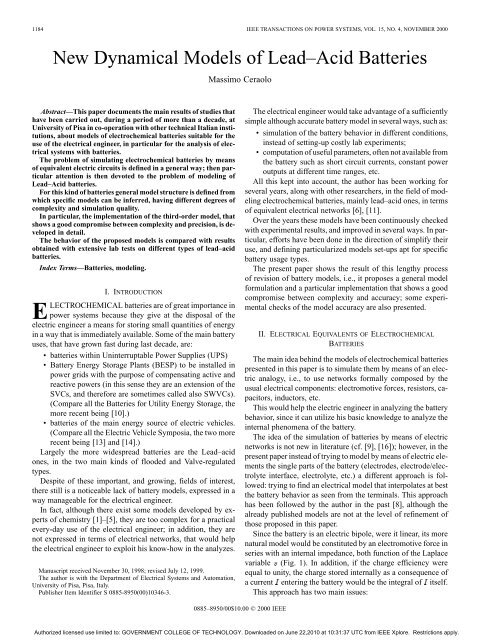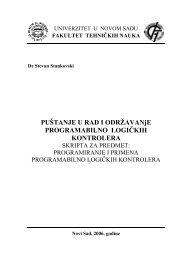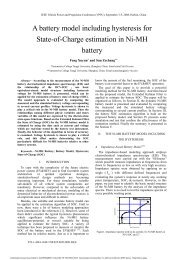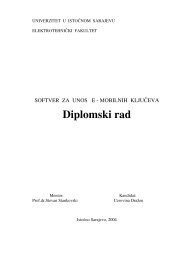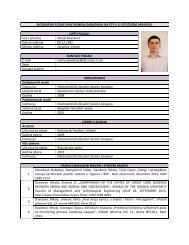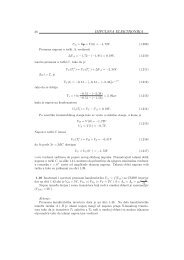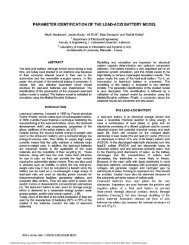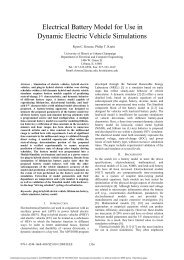New dynamical models of lead-acid batteries - Power Systems, IEEE ...
New dynamical models of lead-acid batteries - Power Systems, IEEE ...
New dynamical models of lead-acid batteries - Power Systems, IEEE ...
Create successful ePaper yourself
Turn your PDF publications into a flip-book with our unique Google optimized e-Paper software.
1184 <strong>IEEE</strong> TRANSACTIONS ON POWER SYSTEMS, VOL. 15, NO. 4, NOVEMBER 2000<br />
<strong>New</strong> Dynamical Models <strong>of</strong> Lead–Acid Batteries<br />
Massimo Ceraolo<br />
Abstract—This paper documents the main results <strong>of</strong> studies that<br />
have been carried out, during a period <strong>of</strong> more than a decade, at<br />
University <strong>of</strong> Pisa in co-operation with other technical Italian institutions,<br />
about <strong>models</strong> <strong>of</strong> electrochemical <strong>batteries</strong> suitable for the<br />
use <strong>of</strong> the electrical engineer, in particular for the analysis <strong>of</strong> electrical<br />
systems with <strong>batteries</strong>.<br />
The problem <strong>of</strong> simulating electrochemical <strong>batteries</strong> by means<br />
<strong>of</strong> equivalent electric circuits is defined in a general way; then particular<br />
attention is then devoted to the problem <strong>of</strong> modeling <strong>of</strong><br />
Lead–Acid <strong>batteries</strong>.<br />
For this kind <strong>of</strong> <strong>batteries</strong> general model structure is defined from<br />
which specific <strong>models</strong> can be inferred, having different degrees <strong>of</strong><br />
complexity and simulation quality.<br />
In particular, the implementation <strong>of</strong> the third-order model, that<br />
shows a good compromise between complexity and precision, is developed<br />
in detail.<br />
The behavior <strong>of</strong> the proposed <strong>models</strong> is compared with results<br />
obtained with extensive lab tests on different types <strong>of</strong> <strong>lead</strong>–<strong>acid</strong><br />
<strong>batteries</strong>.<br />
Index Terms—Batteries, modeling.<br />
I. INTRODUCTION<br />
ELECTROCHEMICAL <strong>batteries</strong> are <strong>of</strong> great importance in<br />
power systems because they give at the disposal <strong>of</strong> the<br />
electric engineer a means for storing small quantities <strong>of</strong> energy<br />
in a way that is immediately available. Some <strong>of</strong> the main battery<br />
uses, that have grown fast during last decade, are:<br />
• <strong>batteries</strong> within Uninterruptable <strong>Power</strong> Supplies (UPS)<br />
• Battery Energy Storage Plants (BESP) to be installed in<br />
power grids with the purpose <strong>of</strong> compensating active and<br />
reactive powers (in this sense they are an extension <strong>of</strong> the<br />
SVCs, and therefore are sometimes called also SWVCs).<br />
(Compare all the Batteries for Utility Energy Storage, the<br />
more recent being [10].)<br />
• <strong>batteries</strong> <strong>of</strong> the main energy source <strong>of</strong> electric vehicles.<br />
(Compare all the Electric Vehicle Symposia, the two more<br />
recent being [13] and [14].)<br />
Largely the more widespread <strong>batteries</strong> are the Lead–<strong>acid</strong><br />
ones, in the two main kinds <strong>of</strong> flooded and Valve-regulated<br />
types.<br />
Despite <strong>of</strong> these important, and growing, fields <strong>of</strong> interest,<br />
there still is a noticeable lack <strong>of</strong> battery <strong>models</strong>, expressed in a<br />
way manageable for the electrical engineer.<br />
In fact, although there exist some <strong>models</strong> developed by experts<br />
<strong>of</strong> chemistry [1]–[5], they are too complex for a practical<br />
every-day use <strong>of</strong> the electrical engineer; in addition, they are<br />
not expressed in terms <strong>of</strong> electrical networks, that would help<br />
the electrical engineer to exploit his know-how in the analyzes.<br />
Manuscript received November 30, 1998; revised July 12, 1999.<br />
The author is with the Department <strong>of</strong> Electrical <strong>Systems</strong> and Automation,<br />
University <strong>of</strong> Pisa, Pisa, Italy.<br />
Publisher Item Identifier S 0885-8950(00)10346-3.<br />
The electrical engineer would take advantage <strong>of</strong> a sufficiently<br />
simple although accurate battery model in several ways, such as:<br />
• simulation <strong>of</strong> the battery behavior in different conditions,<br />
instead <strong>of</strong> setting-up costly lab experiments;<br />
• computation <strong>of</strong> useful parameters, <strong>of</strong>ten not available from<br />
the battery such as short circuit currents, constant power<br />
outputs at different time ranges, etc.<br />
All this kept into account, the author has been working for<br />
several years, along with other researchers, in the field <strong>of</strong> modeling<br />
electrochemical <strong>batteries</strong>, mainly <strong>lead</strong>–<strong>acid</strong> ones, in terms<br />
<strong>of</strong> equivalent electrical networks [6], [11].<br />
Over the years these <strong>models</strong> have been continuously checked<br />
with experimental results, and improved in several ways. In particular,<br />
efforts have been done in the direction <strong>of</strong> simplify their<br />
use, and defining particularized <strong>models</strong> set-ups apt for specific<br />
battery usage types.<br />
The present paper shows the result <strong>of</strong> this lengthy process<br />
<strong>of</strong> revision <strong>of</strong> battery <strong>models</strong>, i.e., it proposes a general model<br />
formulation and a particular implementation that shows a good<br />
compromise between complexity and accuracy; some experimental<br />
checks <strong>of</strong> the model accuracy are also presented.<br />
II. ELECTRICAL EQUIVALENTS OF ELECTROCHEMICAL<br />
BATTERIES<br />
The main idea behind the <strong>models</strong> <strong>of</strong> electrochemical <strong>batteries</strong><br />
presented in this paper is to simulate them by means <strong>of</strong> an electric<br />
analogy, i.e., to use networks formally composed by the<br />
usual electrical components: electromotive forces, resistors, capacitors,<br />
inductors, etc.<br />
This would help the electric engineer in analyzing the battery<br />
behavior, since it can utilize his basic knowledge to analyze the<br />
internal phenomena <strong>of</strong> the battery.<br />
The idea <strong>of</strong> the simulation <strong>of</strong> <strong>batteries</strong> by means <strong>of</strong> electric<br />
networks is not new in literature (cf. [9], [16]); however, in the<br />
present paper instead <strong>of</strong> trying to model by means <strong>of</strong> electric elements<br />
the single parts <strong>of</strong> the battery (electrodes, electrode/electrolyte<br />
interface, electrolyte, etc.) a different approach is followed:<br />
trying to find an electrical model that interpolates at best<br />
the battery behavior as seen from the terminals. This approach<br />
has been followed by the author in the past [8], although the<br />
already published <strong>models</strong> are not at the level <strong>of</strong> refinement <strong>of</strong><br />
those proposed in this paper.<br />
Since the battery is an electric bipole, were it linear, its more<br />
natural model would be constituted by an electromotive force in<br />
series with an internal impedance, both function <strong>of</strong> the Laplace<br />
variable (Fig. 1). In addition, if the charge efficiency were<br />
equal to unity, the charge stored internally as a consequence <strong>of</strong><br />
a current entering the battery would be the integral <strong>of</strong> itself.<br />
This approach has two main issues:<br />
0885–8950/00$10.00 © 2000 <strong>IEEE</strong><br />
Authorized licensed use limited to: GOVERNMENT COLLEGE OF TECHNOLOGY. Downloaded on June 22,2010 at 10:31:37 UTC from <strong>IEEE</strong> Xplore. Restrictions apply.
CERAOLO: NEW DYNAMIC MODELS OF LEAD–ACID BATTERIES 1185<br />
Fig. 1.<br />
Simple battery electric equivalent.<br />
Fig. 3. Battery voltage response to a current stepping from I (constant) to 0.<br />
Fig. 4.<br />
Lead–<strong>acid</strong> battery equivalent network.<br />
Fig. 2.<br />
Battery electric equivalent taking into account a parasitic reaction.<br />
1) the battery behavior is far from being linear; in particular<br />
the internal elements and are function at least <strong>of</strong> the<br />
battery state <strong>of</strong> charge and electrolyte temperature;<br />
2) in general the charge efficiency cannot be considered<br />
equal to 1.<br />
On the other hand, the dependence <strong>of</strong> on can be dropped.<br />
To tackle these issues, the electric network can modified as<br />
indicated in Fig. 2, where:<br />
• represents a measure <strong>of</strong> the electrolyte temperature;<br />
• is a measure <strong>of</strong> the battery state-<strong>of</strong>-charge (later on<br />
details will be given on this quantity).<br />
In this model the charge stored in the battery is the integral <strong>of</strong><br />
only a part <strong>of</strong> the total current entering the battery; therefore<br />
the parasitic branch (subscript ) <strong>models</strong> nonreversible,<br />
parasitic reactions <strong>of</strong>ten present in the battery, that draw some<br />
current that does not participate at the main, reversible, reaction.<br />
The voltage that feeds the parasitic branch is near to battery<br />
voltage at the pins, separated from the latter by only a resistance,<br />
called in figure.<br />
The energy that enters the e.m.f. force abandons the state<br />
<strong>of</strong> electric power, and is converted into other forms <strong>of</strong> energy.<br />
For instance, for <strong>lead</strong>–<strong>acid</strong> <strong>batteries</strong>, the parasitic branch <strong>models</strong><br />
the water electrolysis that occurs at the end <strong>of</strong> the charge process<br />
and the energy entering is absorbed by the reaction <strong>of</strong> water<br />
dissociation.<br />
The power dissipated in the real parts <strong>of</strong> impedances and<br />
is converted into heat, that contributes to the heating <strong>of</strong> the<br />
battery itself.<br />
The electric network represented in Fig. 2 constitutes the<br />
basis on which the battery <strong>models</strong> presented in this paper are<br />
built. To build usable <strong>models</strong> there is the need <strong>of</strong>:<br />
• explicit determination <strong>of</strong> the functional relations reported<br />
in the scheme, i.e., functional dependence <strong>of</strong> the ’s and<br />
’s on and ;<br />
• determination <strong>of</strong> a battery thermal model so that, starting<br />
from information on the temperature <strong>of</strong> the air surrounding<br />
the battery and some computation <strong>of</strong> the heat generated<br />
internally, the electrolyte temperature (measured for simplicity<br />
by a unique value ) can be computed.<br />
The dependence <strong>of</strong> the impedances <strong>of</strong> Fig. 2 on can<br />
be stated implicitly by defining for each <strong>of</strong> them equivalent<br />
– – networks, whose impedance as a function <strong>of</strong> is equal<br />
to the impedance modeled.<br />
III. SIMULATION OF LEAD–ACID BATTERIES<br />
A. Electric Networks<br />
The job <strong>of</strong> making a specific version <strong>of</strong> the model represented<br />
in Fig. 2 for a specific type <strong>of</strong> battery is simplified if there is<br />
some a priori knowledge <strong>of</strong> operating conditions in which the<br />
parasitic branch is not active (draws a negligible current).<br />
This is the case <strong>of</strong> <strong>lead</strong>–<strong>acid</strong> <strong>batteries</strong>. In fact, it is well known<br />
that these <strong>batteries</strong> have a charge efficiency very near to unity<br />
when the battery voltage is well below a threshold on the battery<br />
voltage, which is around 2.3 V per cell.<br />
1) Main (Reversible) Reaction Branch: Under the hypothesis<br />
that the parasitic reactions are inactive, and therefore the<br />
parasitic reaction branch shown in Fig. 2 draws no current,<br />
the main branch <strong>of</strong> the model can be identified by looking at the<br />
battery step responses, measured at different values <strong>of</strong> state-<strong>of</strong>charge<br />
and electrolyte temperature.<br />
A sample battery response to a step current (from const<br />
to 0) is shown in Fig. 3.<br />
Depending on the requested precision, this response can be<br />
approximated by a sum <strong>of</strong> exponential curves, with different<br />
time constants, plus a term proportional to the step current :<br />
The same response can be obtained subjecting to the same<br />
step current the circuit represented in Fig. 4 (in which the branch<br />
between nodes P and N is neglected), where<br />
Authorized licensed use limited to: GOVERNMENT COLLEGE OF TECHNOLOGY. Downloaded on June 22,2010 at 10:31:37 UTC from <strong>IEEE</strong> Xplore. Restrictions apply.
1186 <strong>IEEE</strong> TRANSACTIONS ON POWER SYSTEMS, VOL. 15, NO. 4, NOVEMBER 2000<br />
However, as already noted, the elements <strong>of</strong> this circuit are not<br />
constant, since they depend on the battery state-<strong>of</strong>-charge and<br />
electrolyte temperature (with a good degree <strong>of</strong> approximation,<br />
however, the quantities<br />
can be kept constant).<br />
In addition, partially deviating from the problem proposition<br />
<strong>of</strong> Section II, to accurately describe the battery behavior a dependence<br />
<strong>of</strong> the instantaneous value <strong>of</strong> one <strong>of</strong> the resistances<br />
on the instantaneous value <strong>of</strong> the current flowing inside should<br />
be added.<br />
The process <strong>of</strong> identification is therefore very complex, and<br />
fast increasing with the number <strong>of</strong> the – blocks considered<br />
in the model.<br />
However, a particular installation <strong>of</strong> a battery is normally<br />
characterized by a specific speed <strong>of</strong> evolution <strong>of</strong> the electric<br />
quantities: e.g., there are installations in which the quantities<br />
evolve very rapidly (e.g. the electric vehicles), and other in<br />
which they are rather slow (many industrial applications).<br />
In all these cases the model is requested to be very accurate<br />
only with specific currents/voltages shapes, and the number <strong>of</strong><br />
– blocks can therefore be kept limited (just one or two),<br />
given that the their dynamic behavior is optimized with the more<br />
frequent current/voltage shapes.<br />
If, on the contrary, the same battery is to be utilized in situations<br />
widely different from each other, more blocks are needed<br />
even if this complicates the identification <strong>of</strong> the numerical<br />
values <strong>of</strong> parameters.<br />
2) Parasitic Reaction Branch: The parasitic reaction branch<br />
is <strong>of</strong> the type reported for in Fig. 2.<br />
Experiences conducted on several <strong>lead</strong> <strong>acid</strong> <strong>batteries</strong>, however,<br />
have shown that can be assumed to be a simple resistor,<br />
without dependence on the Laplace variable , and .<br />
On the other hand, a linear model as represented in Fig. 2 is<br />
unrealistic, since the dependence <strong>of</strong> the current on the voltage<br />
is strongly nonlinear.<br />
It seems to be therefore better to express this branch in a way<br />
that evidences its algebraic and nonlinear nature, as in Fig. 4.<br />
Electric Network for Modeling Charge and Discharge<br />
Processes: As a consequence <strong>of</strong> the above considerations a<br />
network able to model both charge and discharge processes is<br />
shown in Fig. 4.<br />
A particularity <strong>of</strong> the main reaction branch that has not<br />
been discussed yet is that when the battery is nearly full the<br />
impedance <strong>of</strong> the main reaction branch becomes greater and<br />
greater; this results in an increase <strong>of</strong> the voltage at the parasitic<br />
branch terminals, which in turn causes a rise <strong>of</strong> the current .<br />
This phenomenon can be described in the proposed model by<br />
means <strong>of</strong> the dependence <strong>of</strong> , on . In particular, a<br />
good interpolation <strong>of</strong> experimental results is obtained if one<br />
<strong>of</strong> the – blocks, say the block , is considered as having<br />
and so that approaches to infinity<br />
as far as the battery approaches to a full state.<br />
B. Capacity, State-<strong>of</strong>-Charge and Electrolyte Temperature<br />
According to what has been previously stated, the battery<br />
modeling requires the identification <strong>of</strong> several circuit elements<br />
(those reported in Fig. 4) under different values its State <strong>of</strong><br />
charge.<br />
Since the definitions <strong>of</strong> this quantity <strong>of</strong> different authors are<br />
<strong>of</strong>ten different [2], [3], [16], a precise definition <strong>of</strong> it is needed<br />
before detailing the relationship <strong>of</strong> the electric elements <strong>of</strong> the<br />
proposed equivalent networks and the state-<strong>of</strong>-charge.<br />
To define the battery state-<strong>of</strong>-charge, a good starting point is<br />
the analysis <strong>of</strong> the battery capacity as a function <strong>of</strong> electrolyte<br />
temperature and discharge current.<br />
It is well known that the charge that can be drawn from a<br />
<strong>lead</strong>–<strong>acid</strong> battery with a constant discharge current at a constant<br />
electrolyte temperature is higher with higher electrolyte temperatures<br />
and lower discharge current. It depends also on the<br />
voltage reached at the end <strong>of</strong> the considered discharge to measure<br />
the capacity.<br />
At a fixed discharge current , 1 (and fixed end-<strong>of</strong>-discharge<br />
voltage) 2 the dependence <strong>of</strong> the capacity on the electrolyte temperature<br />
(expressed in C and supposed constant) can be expressed<br />
with a good approximation by:<br />
where:<br />
• is the electrolyte freezing temperature that depends<br />
mainly on the electrolyte specific gravity, and can normally<br />
be assumed as equal to C.<br />
• is an empirical function <strong>of</strong> discharge current and is,<br />
obviously, equal to the battery capacity at 0 C;<br />
Obviously, the (1) is such that the capacity tends to zero when<br />
approaches to , since when the electrolyte is frozen the battery<br />
is not able to deliver any current.<br />
Experimental results show [6]–[8] that can be expressed<br />
as a function <strong>of</strong> a reference current by:<br />
where it has obviously been assumed . and<br />
are an empirical coefficients, constant for a given battery and a<br />
given . Eq. (2) gives good results in a wide range <strong>of</strong> currents<br />
around ; therefore, a good choice <strong>of</strong> is a current that flows<br />
in the battery for a typical use, e.g., the nominal current ,<br />
defined as the ratio <strong>of</strong> the nominal capacity and the nominal<br />
discharge time . The range <strong>of</strong> currents for which the (2) gives<br />
good results is sufficiently large so that a unique value <strong>of</strong> is<br />
normally chosen for a given battery application.<br />
Eqs. (1) and (2) can be combined into:<br />
1 Positive when exiting the battery, differently from the positive signs indicated<br />
in Figs. 1 and 2.<br />
2 In particular, according to some international standards (CENELEC EN<br />
60 896-1), 1.8 V/element has been assumed. The charge that can be extracted at<br />
end-<strong>of</strong>-discharge voltages different from this value can be obtained simulating<br />
the battery behavior by means <strong>of</strong> one <strong>of</strong> the <strong>models</strong> presented in this paper.<br />
(1)<br />
(2)<br />
(3)<br />
Authorized licensed use limited to: GOVERNMENT COLLEGE OF TECHNOLOGY. Downloaded on June 22,2010 at 10:31:37 UTC from <strong>IEEE</strong> Xplore. Restrictions apply.
CERAOLO: NEW DYNAMIC MODELS OF LEAD–ACID BATTERIES 1187<br />
A rapid comparison between (2) and the frequently adopted<br />
Peukert’s equation (cf. [3]):<br />
const<br />
shows that, although more complicated, (2) overcomes the chief<br />
inadequacies <strong>of</strong> Peukert’s equation, i.e., the lack <strong>of</strong> consideration<br />
<strong>of</strong> the temperature, and the fact that in correspondence to<br />
low currents it predicts capacities much larger than those experimentally<br />
obtainable (up to infinite capacity at zero current).<br />
Equations (1) and (2) have been declared valid when electrolyte<br />
temperature and discharge current are constant.<br />
During transients it can be postulated that they are still valid<br />
given that instead <strong>of</strong> the real battery current a filtered value<br />
<strong>of</strong> this current is used.<br />
This hypothesis has been experimentally confirmed, and is<br />
assumed in this paper; in particular, good results are obtained<br />
taking where is the current flowing in one <strong>of</strong><br />
the resistors (the actual depends on the particular model<br />
considered), and it is , .<br />
When simulating the battery using this model, the capacity<br />
must be on-line adapted to the computed actual electrolyte temperature<br />
and average current: .<br />
A per unit measure <strong>of</strong> the level <strong>of</strong> the discharge <strong>of</strong> a battery<br />
has to correlate the charge that has been actually extracted<br />
from the battery starting from a battery completely full with the<br />
charge that can be extracted under given, standard conditions.<br />
In the <strong>models</strong> proposed in this paper two different numbers<br />
are sued to quantify the level <strong>of</strong> discharge <strong>of</strong> the battery:<br />
• state-<strong>of</strong>-charge<br />
• depth-<strong>of</strong>-charge<br />
where (supposed that when the<br />
battery is completely full).<br />
The physical meaning <strong>of</strong> and is quite simple:<br />
while the first one is an indicator <strong>of</strong> how full is a battery with<br />
reference to the maximum capacity the battery is able to deliver<br />
at the given temperature , the second one is an indicator <strong>of</strong> how<br />
full is the battery with reference to the actual discharge regime<br />
(i.e., the value <strong>of</strong> the constant discharge current , or, in case <strong>of</strong><br />
variable current the value <strong>of</strong> ).<br />
1) Electrolyte Temperature: It has been stated in Section II<br />
that the elements <strong>of</strong> the electric equivalents <strong>of</strong> electrochemical<br />
have to be computed for each electrolyte temperature. In fact,<br />
since the <strong>batteries</strong> are extensive components, each electrolyte<br />
point has a temperature <strong>of</strong> its own.<br />
However, to avoid this additional complexity, in the proposed<br />
model a unique value has been assumed, that is somehow an<br />
equivalent <strong>of</strong> the whole temperature map.<br />
Then, the dynamic equation that allows the electrolyte temperature<br />
computation is, simply:<br />
or, equivalently:<br />
Fig. 5.<br />
Equivalent electric network used for the third-order battery model.<br />
where:<br />
is the battery thermal capacitance<br />
is the electrolyte temperature<br />
is thermal resistance between the battery and its<br />
environment<br />
is the ambient temperature i.e., the temperature <strong>of</strong> the<br />
environment (normally air) surrounding the battery<br />
is source thermal power, i.e., the heat that is generated<br />
internally in the battery<br />
is the variable <strong>of</strong> the Laplace transform.<br />
When a battery module contains more than one element, a<br />
unique temperature for the electrolyte <strong>of</strong> the whole module can<br />
be utilized.<br />
C. Model Parameters<br />
It has been previously stated that the battery can be simulated<br />
by electric networks <strong>of</strong> the types shown in Fig. 4, in which the<br />
numerical values <strong>of</strong> the elements <strong>of</strong> these networks have to be<br />
computed for each value <strong>of</strong> electrolyte temperature and state-<strong>of</strong>charge.<br />
Obviously, in practice they can computed only for discrete<br />
values <strong>of</strong> these two quantities, and the values between are<br />
to be obtained by means <strong>of</strong> some form <strong>of</strong> interpolation.<br />
To simplify the task, a large amount <strong>of</strong> <strong>lead</strong>–<strong>acid</strong> battery data<br />
have been processed to find analytical functions able to reproduce<br />
the typical behavior <strong>of</strong> the elements <strong>of</strong> Fig. 4, (i.e. e.m.f.’s,<br />
’s, ’s) as function <strong>of</strong> and/or , and . These functions<br />
contain some numerical coefficients (The “model parameters”)<br />
to be computed based on experimental battery tests.<br />
In the following paragraph, these analytical functions are reported,<br />
with reference to one <strong>of</strong> the possible <strong>models</strong> that can be<br />
built based on the electric equivalent <strong>of</strong> Section III-A, i.e., that<br />
in which two – blocks are present.<br />
D. Third-Order Model Formulation<br />
Among the several possibilities given by the modeling techniques<br />
described in the previous paragraphs one <strong>of</strong> the most suitable<br />
for general-purpose modeling is constituted by:<br />
• an electric equivalent with two – blocks and an algebraic<br />
parasitic branch (Fig. 5);<br />
• algorithms for computing the state <strong>of</strong> charge and internal<br />
(electrolyte) temperature<br />
• equations for computation <strong>of</strong> the elements <strong>of</strong> the equivalent<br />
electric network as function <strong>of</strong> state <strong>of</strong> charge and<br />
temperature.<br />
Authorized licensed use limited to: GOVERNMENT COLLEGE OF TECHNOLOGY. Downloaded on June 22,2010 at 10:31:37 UTC from <strong>IEEE</strong> Xplore. Restrictions apply.
1188 <strong>IEEE</strong> TRANSACTIONS ON POWER SYSTEMS, VOL. 15, NO. 4, NOVEMBER 2000<br />
The assumed state variables are the currents and , and the<br />
extracted charge and electrolyte temperature . The dynamic<br />
equations <strong>of</strong> the model are therefore:<br />
where<br />
and the other quantities have the previously<br />
reported meaning.<br />
The assumed equations for , , , , are: 3<br />
where , , , , , , , are constant for<br />
a particular battery (later some information on how to determine<br />
these numbers will be given). DOC and SOC are as defined in<br />
Section III-B, and the current to be utilized in the expression <strong>of</strong><br />
the capacity is .<br />
The behavior <strong>of</strong> the parasitic branch is actually strongly nonlinear.<br />
Therefore it is better to use, instead <strong>of</strong> , an expression<br />
<strong>of</strong> as a function <strong>of</strong> . The following equation can be used,<br />
that matches the Tafel gassing–current relationship [7]<br />
or, equivalently:<br />
These expressions contain the parameters , , , that<br />
are constant for a particular battery. In case <strong>of</strong> recombination<br />
<strong>batteries</strong> the Tafel relationship, and therefore the above reported<br />
expression <strong>of</strong> is valid only up the recombination limit; this is<br />
not a strong limitation since this limit should never be overcome<br />
(otherwise the battery is irreversibly damaged).<br />
Although the strong nonlinearity <strong>of</strong> the parasitic reaction<br />
branch reduces a lot the physical meaning <strong>of</strong> e.m.f. and<br />
resistor , it can be written (cf. Fig. 2):<br />
const<br />
The computation <strong>of</strong> allows the computation <strong>of</strong> the heat<br />
produced by the parasitic reactions, by means <strong>of</strong> the Joule law:<br />
. For recombination <strong>batteries</strong> all the power entering<br />
the parasitic reactions branch, therefore it is .<br />
It is important to note that since during discharge<br />
and , if only the discharge behavior is to be simulated,<br />
the resistor and the whole parasitic branch can be omitted<br />
from the model.<br />
The equations <strong>of</strong> the proposed model formulation contain<br />
some constants whose numerical values are in principle to be<br />
determined for each battery by means <strong>of</strong> lab tests. The whole<br />
3 Needless to say, 273 + indicates the electrolyte temperature measured in<br />
Kelvin.<br />
set <strong>of</strong> numerical constants that define all details <strong>of</strong> the model<br />
for a particular battery is composed as follows.<br />
Parameters referring<br />
to the battery capacity<br />
Parameters referring<br />
to the main branch <strong>of</strong><br />
the electric equivalent<br />
Parameters referring<br />
to the parasitic<br />
reaction branch <strong>of</strong><br />
the electric equivalent<br />
Parameters referring<br />
to the battery<br />
thermal model<br />
1) Identification <strong>of</strong> Model Parameters: Given the large <strong>of</strong><br />
number <strong>of</strong> parameters <strong>of</strong> the proposed model, the complete identification<br />
<strong>of</strong> all <strong>of</strong> them is particularly complex. However, the<br />
following considerations apply:<br />
• as already noted for discharge modeling only, , ,<br />
, , do not need to be computed;<br />
• the a dimensional parameters (i.e., , , , , ,<br />
) vary a little among different <strong>batteries</strong> built with the<br />
same technology, and as a first approximation the values<br />
reported in the Appendix can be utilized;<br />
• when <strong>batteries</strong> <strong>of</strong> the same manufacturer and model (and<br />
different nominal capacities) are considered, the parameters<br />
having the dimensions <strong>of</strong> a resistance can be approximately<br />
taken as inversely proportional to nominal<br />
capacities.<br />
The problem <strong>of</strong> individuation <strong>of</strong> the numerical values <strong>of</strong> all<br />
the battery parameters, as well as some techniques to reduce the<br />
difficulty <strong>of</strong> this task, is analyzed in detail in a different paper<br />
that will be soon submitted for publication.<br />
IV. MODEL VALIDATION<br />
The <strong>models</strong> presented in this paper have been validated by<br />
means <strong>of</strong> many lab tests made on <strong>lead</strong>–<strong>acid</strong> <strong>batteries</strong> <strong>of</strong> several<br />
types (flooded, gelled, Valve-Regulated).<br />
A specialized model for Sodium–Sulfur <strong>batteries</strong>, based on<br />
the general principles discussed in Section II has also been successfully<br />
checked with lab tests [11].<br />
The model validation is strictly related to the problem <strong>of</strong><br />
model parameters identification, that will be tackled in detail<br />
in a different paper. However, just to give some examples, hereafter<br />
the comparison <strong>of</strong> simulated and measured voltage shape<br />
for two <strong>batteries</strong> for simple transients is reported.<br />
The considered <strong>batteries</strong> are:<br />
• Battery 1: valve-regulated <strong>lead</strong> <strong>acid</strong> (gelled),<br />
Ah<br />
• Battery 2: flooded <strong>lead</strong> <strong>acid</strong>, Ah<br />
The behavior <strong>of</strong> these <strong>batteries</strong> can be simulated using the<br />
third-order formulation <strong>of</strong> the battery <strong>models</strong> presented in this<br />
paper and the parameters reported in the Appendix.<br />
Authorized licensed use limited to: GOVERNMENT COLLEGE OF TECHNOLOGY. Downloaded on June 22,2010 at 10:31:37 UTC from <strong>IEEE</strong> Xplore. Restrictions apply.
CERAOLO: NEW DYNAMIC MODELS OF LEAD–ACID BATTERIES 1189<br />
Fig. 7. Comparison <strong>of</strong> simulated and measured battery voltage during charge<br />
(battery 2).<br />
Again, a good agreement <strong>of</strong> simulated and measured curves is<br />
shown, although the model shows some difficulty <strong>of</strong> integration<br />
when the battery is nearly full.<br />
V. CONCLUSION<br />
Fig. 6. Comparison <strong>of</strong> simulated and measured battery voltage for a<br />
constant-current discharge up to 1.75 V followed by a period in which the<br />
current is constantly null.<br />
In Fig. 6 the simple transient constituted by a constant-current<br />
discharge up to a element voltage equal to 1.75 V followed by a<br />
period in which the current is constantly null is considered. In all<br />
the plots the voltage <strong>of</strong> a single battery element, both simulated<br />
and measured are shown.<br />
Fig. 6(a) and (b) refer to battery 1. The current is equal to<br />
58 A for a duration <strong>of</strong> 8.6 h, then it is 0.<br />
Fig. 6(c) and (d) refer to battery 2. The current is equal to<br />
63 A for a duration <strong>of</strong> 7.2 h, then it is 0.<br />
Both figures show a good agreement <strong>of</strong> measured and simulated<br />
shapes.<br />
For battery 2, the model is checked also during the charge<br />
process. The comparison <strong>of</strong> measured and simulated voltage<br />
for a 53 A charge (starting from a completely empty battery)<br />
is shown in Fig. 7.<br />
• The complex, nonlinear behavior <strong>of</strong> electrochemical <strong>batteries</strong><br />
can be conveniently modeled using equivalent electric<br />
networks. Although these networks contain elements<br />
that are nonlinear and depend on battery state-<strong>of</strong>-charge<br />
and electrolyte temperature, they are very useful for the<br />
electric engineer, since they allow to think in terms <strong>of</strong> electric<br />
quantities, instead <strong>of</strong> internal battery electrochemical<br />
reactions.<br />
• The third-order model proposed has an accuracy satisfactory<br />
for the majority <strong>of</strong> uses; for particular situations<br />
more sophisticated <strong>models</strong> can be derived from the general<br />
model structure proposed in the paper.<br />
• The proposed model can be used for several purposes; the<br />
more important fields <strong>of</strong> application are:<br />
— computer simulation <strong>of</strong> battery behavior under different<br />
operating conditions (possibly containing both<br />
charge and discharge processes);<br />
— management <strong>of</strong> on-line systems containing electrochemical<br />
<strong>batteries</strong>: state-<strong>of</strong>-charge estimation, battery<br />
monitoring and diagnostics; estimate <strong>of</strong> residual range<br />
<strong>of</strong> electric vehicles [12], [15].<br />
• The use <strong>of</strong> the proposed <strong>models</strong>, in particular the thirdorder<br />
formulation, is complicated by the fact that the proposed<br />
equations contain several parameters that have to be<br />
identified. This identification can however be simplified a<br />
lot since some <strong>of</strong> the parameters can be taken as constant<br />
for all the <strong>batteries</strong> built with the same technology.<br />
APPENDIX<br />
MODEL PARAMETERS USED FOR SIMULATIONS<br />
TABLE I<br />
PARAMETERS OF BATTERY 1(ONLY PARAMETERS NEEDED FOR<br />
DISCHARGE SIMULATIONS)<br />
Authorized licensed use limited to: GOVERNMENT COLLEGE OF TECHNOLOGY. Downloaded on June 22,2010 at 10:31:37 UTC from <strong>IEEE</strong> Xplore. Restrictions apply.
1190 <strong>IEEE</strong> TRANSACTIONS ON POWER SYSTEMS, VOL. 15, NO. 4, NOVEMBER 2000<br />
TABLE II<br />
PARAMETERS OF BATTERY 2(ALL PARAMETERS)<br />
ACKNOWLEDGMENT<br />
The author would like to thank Pr<strong>of</strong>. R. Giglioli for his guidance<br />
during the past years on the field <strong>of</strong> battery modeling, and<br />
F. Buonsignori for his intelligent contribution to all the lab tests<br />
on which this paper is based.<br />
REFERENCES<br />
[1] M. Shepard, “Design <strong>of</strong> primary and secondary cells, an equation describing<br />
battery discharge,” Journal Electrochemical Society, July 1965.<br />
[2] K. J. Vetter, Electrochemical Kinetics, 1967.<br />
[3] H. Bode, Lead–Acid Batteries: J. Wiley & Sons, 1977.<br />
[4] L. Gopikanth and S. Sathyanarana, “Impedance parameters and the<br />
state-<strong>of</strong>-charge,” Journal <strong>of</strong> Applied Electro-Chemistry, pp. 369–379,<br />
1979.<br />
[5] G. Smith, Storage Batteries. London: Pitman Advanced Publishing<br />
Program, 1980.<br />
[6] R. Giglioli, P. Pelacchi, V. Scarioni, A. Buonarota, and P. Menga, “Battery<br />
model <strong>of</strong> charge and discharge processes for optimum design and<br />
management <strong>of</strong> electrical storage systems,” in 33rd International <strong>Power</strong><br />
Source Symposium, June 1988.<br />
[7] H. P. Schoner, “Electrical behavior <strong>of</strong> <strong>lead</strong>/<strong>acid</strong> <strong>batteries</strong> during charge,<br />
overcharge, and open circuit,” in 9th Electric Vehicle Symposium<br />
(EVS-9), 1988, N. 063.<br />
[8] R. Giglioli, A. Buonarota, P. Menga, and M. Ceraolo, “Charge and discharge<br />
fourth order dynamic model <strong>of</strong> the <strong>lead</strong>–<strong>acid</strong> battery,” in The 10th<br />
International Electric Vehicle Symposium, Hong-Kong, Dec. 1990.<br />
[9] S. A. Ilangovan, “Determination <strong>of</strong> impedance parameters <strong>of</strong> individual<br />
electrodes and internal resistance <strong>of</strong> <strong>batteries</strong> by a new nondestructive<br />
technique,” Journal <strong>of</strong> <strong>Power</strong> Sources, vol. 50, pp. 33–45, 1994.<br />
[10] Fifth International Conference on Batteries for Utility Energy Storage,<br />
Puerto Rico 1995, July 18–21, 1995, 18-21 luglio.<br />
[11] M. Ceraolo, A. Buonarota, R. Giglioli, P. Menga, and V. Scarioni, “An<br />
electric dynamic model <strong>of</strong> sodium sulfur <strong>batteries</strong> suitable for power<br />
system simulations,” in 11th International Electric Vehicle Symposium,<br />
Florence, Sept. 27–30, 1992.<br />
[12] G. Casavola, M. Ceraolo, M. Conte, G. Giglioli, S. Granella, and G.<br />
Pede, “State-<strong>of</strong>-charge estimation for improving management <strong>of</strong> electric<br />
vehicle <strong>lead</strong>–<strong>acid</strong> <strong>batteries</strong> during charge and discharge,” in 13th<br />
International Electric Vehicle Symposium, Osaka, Oct. 1996.<br />
[13] Proceedings <strong>of</strong> the Fourteenth Electric Vehicle Symposium, vol. EVS-14,<br />
Orlando, USA, Dec. 15–17, 1997.<br />
[14] Proceedings <strong>of</strong> the Fifteenth Electric Vehicle Symposium, vol. EVS-15,<br />
Brussels, Belgium, Sept. 29–Oct. 3, 1998.<br />
[15] M. Ceraolo, D. Prattichizzo, P. Romano, and F. Smargrasse, “Experiences<br />
on residual-range estimation <strong>of</strong> electric vehicles powered by<br />
<strong>lead</strong>–<strong>acid</strong> <strong>batteries</strong>,” in 15th International Electric Vehicle Symposium,<br />
Brussels, Belgium, Sept. 29–Oct. 3, 1998.<br />
[16] H. L. N. Wiegman and R. D. Lorenz, “High efficiency battery state control<br />
and power capability prediction,” in 15th Electric Vehicle Symposium,<br />
vol. EVS-15, Brussels, Belgium, Sept. 29–Oct. 3, 1998.<br />
Massimo Ceraolo (1960) received the degree in electrical<br />
engineering at the University <strong>of</strong> Pisa in 1985.<br />
After the military service, from 1986 to 1991 he<br />
worked in the CRITA, (an engineering company) in<br />
activities <strong>of</strong> research and design <strong>of</strong> electric power systems.<br />
Some <strong>of</strong> his work <strong>of</strong> this period was in collaboration<br />
with <strong>of</strong> University <strong>of</strong> Pisa.<br />
Since 1992, he is a Researcher <strong>of</strong> the “Dipartimento<br />
di Sistemi Elettrici e Automazione” <strong>of</strong><br />
University <strong>of</strong> Pisa.<br />
His major fields <strong>of</strong> interest are active and reactive<br />
compensation <strong>of</strong> power systems, long-distance transmission systems, computer<br />
simulations in power systems, storage <strong>batteries</strong>.<br />
Authorized licensed use limited to: GOVERNMENT COLLEGE OF TECHNOLOGY. Downloaded on June 22,2010 at 10:31:37 UTC from <strong>IEEE</strong> Xplore. Restrictions apply.


